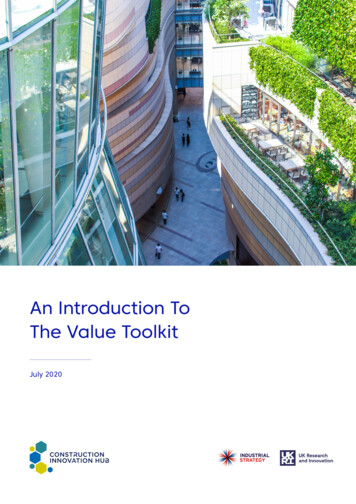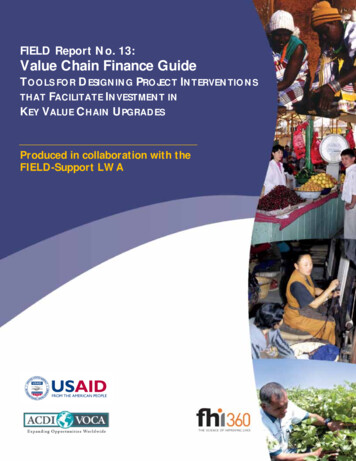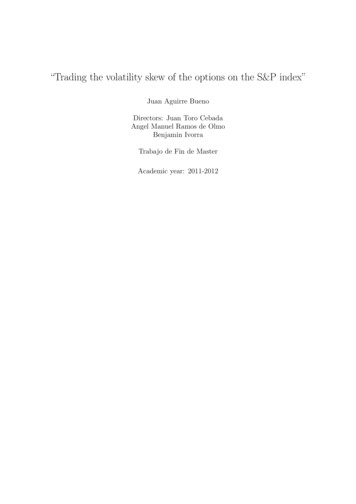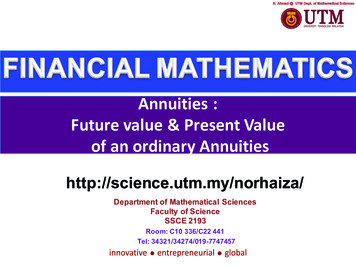
Transcription
An Introduction ToThe Value ToolkitJuly 2020
IntroductionMany projects fail to realise their intended value. Even for projects that aredelivered on time and on budget, the anticipated benefits do not alwaysmaterialise. Why is this?In practice, the reasons are manifold. But it is clearthat inconsistencies in approach, a lack of alignmentin decision-making and a narrow focus on controllingcost and transferring risk in the capital phase – today’stypical approach – are not going to solve this.We need a different approach. One that targetsvalue and whole-life performance. This is theambition set out in the Construction Sector Dealand key policy documents such as the IPA’sTransforming Infrastructure Performance.But what do we mean by “value”, and how canwe best define and measure it? Value does notjust mean cost, nor is it something that existspurely in the construction phase of projects. Valueneeds to consider a broader range of metricsbeyond financial. It must also consider widersocial, economic and environmental factors – andconsider them across the full investment lifecycle.Delivering this definition of value does not needa change in policy. But it does need a change inapproach - one that better reflects broader, strategicpolicy objectives, responds to local ambition andmeets the needs of users, owners and operators.An approach that supports informed decision-makingthroughout the lifecycle and provides industry withthe opportunity to innovate to deliver value in thedesign, delivery and operation.This is why the Construction Innovation Hub is settingout the new Value Toolkit – a suite of tools thatwill drive faster, better decision making to delivermeasurable value improvement.This document provides an introduction to theValue Toolkit – what it is, what it will deliver andhow it will be used.Value Toolkit Overview:A suite of tools to support faster value-based decision-making across the whole investment lifecycleModule 1:Value DefinitionModule 2:Delivery ModelModule 3:Procuring for ValueModule 4:Ongoing MeasurementOverview:Defining the unique valueprofile for a given projectand creating value indicesthrough which informeddecisions can be madeSelection of a deliverymodel and commercialstrategy that best meetsthe value drivers of theprojectHelping the market toshape their offers andhelping clients to makeprocurement decisionsbased on the Value Driversof the projectContinuous forecastingand measurement ofvalue performancethroughout deliveryand operationTools: Value Profile Delivery Model Selector Commercial StrategyDeveloper Procuring for Value Bid Optimisation Project Monitoring Value Indices Procuring for Value Client Evaluation AnalysisAimed at: Asset Monitoring Policy-makers Clients Clients Clients Clients Advisors Advisors Industry Advisors Industry Industry Policy-makersAn Introduction To The Value Toolkit constructioninnovationhub.org.uk1
Module 1: Value DefinitionThe Value Definition module has two key tools which support the creation of a Value Profileand the generation of Value Indices to ensure that each project is aligned with both theclient’s value drivers and broader strategic policy objectives.Creating a Value ProfileEach project or programme will have itsown unique Value Profile – a shape that setsout the Value Drivers for that client, for thatproject, in that location. The Value Profile isestablished by setting the relative importanceof industry-wide Value Categories, basedon the Five Capitals Model. These can bethought of as sliders on a graphic equaliser.NaturalAir Quality, Land Quality,Water Quality, BiodiversitySocialCommunity - Citizens, CommunityEnterprise, Equality, SourcingHumanSafety & Security, Employment, Skills &Training, Mental & Physical Wellbeing Carbon & GHG, Resource Use,Production, ProductivityManufacturedFinancialWhilst the Value Profile is unique to each project,Capital Cost, Operational Cost,Revenue, Economic Benefits The 5 Capitals Model and Value Categoriesthere are national, strategic policy ambitions thatmust be considered. Such strategic ambitionscould include net-zero carbon, levellingup or driving manufacturing approaches,1SHYPI :EPYI (IʘRMXMSR all of which must be reflectedin the relativeNatural100weightings, and therefore the Value Profile.M5 Capitals8 HumanSocial100FinancialManufactured1001001008LI :EPYI (IʘRMXMSR QSHYPI LEW X[S OI] XSSPW [LMGL WYTTSVX XLI GVIEXMSR SJ E :EPYI 4VSʘPI ERH XLI KIRIVEXMSR SJ :EPYI -RHMGIW XS IRWYVI XLEX IEGL TVSNIGX MW EPMKRIH [MXL FSXL XLI In addition, individual departments,clients orclient’svaluedriversand broader strategic policy objectives.funders may have portfolio-level drivers andtargets which further inform the weightingsof certain value categories.For example, it'VIEXMRK E :EPYI 4VSʘPImay be that a departmentwishestoprogrammeplace will have itsEach project orS[R YRMUYI :EPYI 4VSʘPI – a shape that setsincreased emphasis on Productivity in orderSYX XLI :EPYI (VMZIVW JSV XLEX GPMIRX JSV XLEX to accelerate a portfolioTVSNIGX MR XLEX PSGEXMSR 8LI :EPYI 4VSʘPI MW of projects.010%0000AirQuality, Land Quality,15%20%Water Quality, Biodiversity25%NaturalStrategic Minimum Weighting30%Portfolio Minimum WeightingCommunity - Citizens, CommunitySocialAssigning 5-Capitals Weightings Enterprise, Equality, SourcingSafety & Security, Employment, Skills &,YQER17XEKI SGenerT8S GSRt:EPYItone oZgoodDper mlQIXVIametriciand itbA bas 8VEMRMRK 1IRXEP 4L]WMGEP ;IPPFIMRKperforTModule 2: Delivery Modeland Commercial StrategyceResourUseProductionestablished by setting the relative importanceCarbon & GHG, Resource Use,This process provides theofmarketwithValuea clear,industry-wideCategories, basedManufactured1ERYJEGXYVIH4VSHYGXMSR 4VSHYGXMZMX]on theFive Capitals ofModel.can beconsistent and transparentarticulationtheThese e se n e nt ns t t s t e ents se e t e e Capital Cost, Operational Cost,XLSYKLX SJ EW WPMHIVW SR E KVETLMG IUYEPMWIV *MRERGMEP the nu7beingʘ:EPYIm10% wtperforityProductivnrboCa HG&G erivodNatural ialancFintysiDelivery Models, including traditionalconsultantonomAir energy peric7per million pounds, annual operationalBenefitson'ETMX;LMPWX XLI -:- VIʙIGXW TIVJSVQERGI EGVSWW EPP XLI led delivery,through design andindividualdepartments,clientsorolluti build, alliancingPTool 2 - Commercial Strategy DeveloperNaturalWQIXVI WUYEVIH SV GSWX TIV WUYEVI QIXVI XS FYMPH [MXL The project now has its uniqueValue Profile. The approachesvalue categories andmetrics, additional ValueProject 13 andl & new andfunders may have portfolio-leveldriversandsuch as tailoredSolmetricsand benchmarkstoetheprojecttypeonta caurcWithadeliverymodelselected,theclientcaniMing from a subset of the samysCommunity - Citizens, Communityinnovative models such as the platformapproachIndices can be generatedPh eingfurther informtheitsweightingsrelativeweightingsof n.all0bnowbuildthetailoringthe000commercial strategy,0Enterprise, Equality, vationHub.HEXE *SV I\EQTPI F] GSQFMRMRK JEGXSVW MRGPYHMRK &SJ GIVXEMR ZEPYI GEXIKSVMIW *SV I\EQTPI MX lls 10%20%30%be used make informedchoicesthroughouttheSafety & Security, Employment, Skills &nSk benchmarkaccessibility, inclusivity and indoor environmentalA baseline IVI score of 1000 represents theaiSocia,YQERmay be that a department wishesto placeTr Strategic MinimumWeightingPortfolioMinimum WeightingHIPMZIV ZEPYI ERH QMXMKEXI XLIMV VMWO TVSʘPI n n ent s e e n UYEPMX] E es n e n e is automaticallyperformancebeingDeliverymet for Modelall valuecategories, withinvestment lifecycle. The secondtool convertsToolin1orderClientSelectorincreased emphasison Productivity ,YQECarbon & GHG, Resource Use,generated.Such indicesl provide anTheadditionalmeathe number of points associated%WWMKRMRK 'ETMXEPW ;IMKLXMRKWwith Heach category7XIT Ț 4EGOEKMRK ioofprojects.ia t n t t Drawing on mthe outputs of thethis value profileinto a series of Value Indices.being7XIT :EPYI (VMZIVWcJSV GSQTEVMWSR VIʙIGXMRK XLI WTIGMʘG RIIHW SJ E determined by the weightings outlined1ERYan in theETTVSEGL HIʘRIW XLI WTIGMʘG GSRXVEGXW SoʘVWX QSHYPI XLI ʘVWX WXIT QETW XLI EZEMPEFPI HIPMZIV] Capital Cost, Operational Cost,orberegion.:EPYI 4VSʘPI *SV I\EQTPI E ZEPYI GEXIKSV] [MXL E ufactpackagesureinvestor*MRERGMEPtodelivered, these are selected toThis process provides the marketwith a clear,anclient,d *MRER e en e n Benefitsmodels against the project’s e fi e to identifyM10% weightingwill score 100 points if benchmarkʘX [MXLMR XLI HIPMZIV] QSHIP JVSQ XLI GEXEPSKYIconsistent and transparent keyvaluedrivers.%X XLI IRH SJ XLI :EPYI (IʘRMXMSR QSHYPI XLI GPMIR8LI 'ETMXEPW 1SHIP ERH :EPYI 'EXIKSVMIWperformance is achieved.of consultancy and contractor business modelsGSVI :EPYI (VMZIVW EW XLI] ETTP] REXMSREPP] ERH [MPP LEZI TVSHYGIH E TVSNIGX WTIGMʘG :EPYI 4VSʘPI Example Project Value ProfilelThis cataloguecategorises the business models7XIT 6MWO 4VSʘPIV The second step helps totaJSV WTIGMʘG GPMIRXW TVSNIGXW SV TVSKVEQQIW piFEWIPMRI -:- TPYW ER] EHHMXMSREP ZEPYI MRHMGIW 8LIWDefaultperformancerangeswillbegeneratedfor5 CapitalsCa stCoSR XLI FEWMW SJ XLI :EPYI 4VSʘPI XLI] HIPMZIV ERidentifypotential barriers to the realisation of value.lnaSuch consistency will allow industrytoinvesttio stage, at every intervention, toWawill be used at everyeach metric based on the asset type, which maybeeraQu teaOp mitigate – supporting informedr projectrisks they canThis tool will assess the level of risk cticallyhelpinformwhetherchoicesand options2are valueJYVXLIV VIʘRIH JSV IEGL WTIGMʘG TVSNIGX 8LMW TVSZMHIW An Introduction To The ValueToolkitconstructioninnovationhub.org.uk choices in the design of the packaging strategyand again identify those delivery modelsLand which willefor each projectproducts,creating or value destroying.the clientwith the ability to set minimum performanceQuaRevenuFinancial- bringing forwardHumanManufacturedSocialNaturallityhelp mitigate the risks.7XIT Ț 'SRXVEGX MRGIRXMZIW VMWO VI[EVH servicesand solutionswhich deliver better value.100100100100100cAir Quality, Land Quality,In addition,Water Quality, duPro ialancFinNaturalceResourUsenrboCa HG&GityEmityntaluEqityunmm seCo rpriteEn unCommCitizenstysierivodBi tBi e n e t te est fit t e e e s6IZIRYI )GSRSQMG &IRIʘXW7XEKI :EPYI (IʘRMXMSRcore Value Drivers as they apply nationally, and t e e t s n t e n es s ess t es ;LMPWX XLI :EPYI 4VSʘPI MW YRMUYI XS IEGL TVSNIGX 8LI 'ETMXEPW 1SHIP ERH :EPYI 'EXIKSVMIWlfor specific clients, projects or programmes.tapithere are national, strategic policy ambitions thatCa st7oCGeneratingValue IndicesSuch consistency will allowindustryto investDefaual t s s t t e e t n e fi e 5 Capitalsmustbe considered.Such strategicambitionsionWairatQu terpeO7XIT 1EVOIX GSRXI\X gns e t t e e t s ne t t t e sttyWXERHEVHW EKEMRWX GIVXEMR QIXVMGW XS VIʙIGX TVSNIGX8S GSRZIVX XLI :EPYI 4VSʘPI MRXS ER SZIVEPP Investmentstrategically for the market,justnet-zerotacticallyCoTon market sounding to evaluate the currentto work with market to deliver value and to manageJYVXLIup or driving manufacturing e n e IEGL :EPYI 'EXIKSV] MW EWWMKRIH approaches,WTIGMʘG TVMSVMXMIW ERH XEVKIXW *SV I\EQTPI E GPMIRgic policy objectives.afor each project - sationofthatnuveFinancialthe mecliEPP SJ [LMGL QYWX FI VIʙIGXIH MR XLI VIPEXMZI may wishManufacturedto disregardReanyoptions which do notone or more metrics and a benchmarkHumanSocialNaturalQuality representinghrelation to each of the remaining delivery modeZEPYI )ZIV] TVSNIGX MW JEGIH [MXL E GLSMGI SJ HMʗIVIRX E TPERRIH STIRMRK HEXI SV I\GIIH EʗSVHEFMPMX] PMQ100100100100[IMKLXMRKW ERH XLIVIJSVI XLI :EPYI 4VSʘPI good practice. This could be number 100of jobs createdservices and solutions whichdeliver better value.E n AirEconomic&IRI
Stage 1: Value DefinitionGenerating Value IndicesTo convert the Value Profile into an overall InvestmentValue Index (IVI), each Value Category is assignedone or more metrics and a benchmark representinggood practice. This could be number of jobs createdper million pounds, annual operational energy permetre squared, or cost per square metre to build, withmetrics and benchmarks tailored to the project typeand its location.A baseline IVI score of 1000 represents the benchmarkperformance being met for all value categories, withthe number of points associated with each categorybeing determined by the weightings outlined in theValue Profile. For example, a value category with a10% weighting will score 100 points if benchmarkperformance is achieved.Default performance ranges will be generated foreach metric based on the asset type, which may befurther refined for each specific project. This providesthe client with the ability to set minimum performanceCapitalProjectWeighting(%)BaselineIVI d20200Financial30300100%1000ValueCategorystandards against certain metrics to reflect projectspecific priorities and targets. For example, a clientmay wish to disregard any options which do not meeta planned opening date or exceed affordability limits.Whilst the IVI reflects performance across all thevalue categories and metrics, additional ValueIndices can be generated from a subset of the samedata. For example, by combining factors includingaccessibility, inclusivity and indoor environmentalquality, a Design Value Index is automaticallygenerated. Such indices provide an additional meansfor comparison, reflecting the specific needs of aclient, investor or region.At the end of the Value Definition module, the clientwill have produced a project specific Value Profile, abaseline IVI, plus any additional value indices. Thesewill be used at every stage, at every intervention, tohelp inform whether choices and options are valuecreating or value destroying.ProjectWeighting(%)BaselineIVI PointsCarbon & GHG4080Resource Embodied CarbonProjectWeighting (%)BaselineIVI PointsBenchmarkPerformance5040800504043100%80(Kg CO2eq/m2)Operational Carbon(Kg CO2eq/m2/year)Generating the project Investment Value Index (IVI)Note: Metrics and performance figures for example onlyAn Introduction To The Value Toolkit constructioninnovationhub.org.uk3
Module 2: Delivery Model and Commercial StrategyThe second module contains two tools to help clients select a DeliveryModel and build a Commercial Strategy which best fit the value driversof the project, maximising the chances of successful outcomes.The Delivery Model describes how the client proposesto work with market to deliver value and to managethe risks that may prevent the realisation of thatvalue. Every project is faced with a choice of differentDelivery Models, including traditional consultantled delivery, through design and build, alliancingapproaches such as Project 13 and new andinnovative models such as the platform approachbeing developed by the Construction Innovation Hub.Step 4 - Market context: The fourth step drawson market sounding to evaluate the currentappetite, capacity and capability of the market inrelation to each of the remaining delivery models.Tool 2 - Commercial Strategy DeveloperWith a delivery model selected, the client cannow build the commercial strategy, tailoring thepackages, contracts and reward mechanisms todeliver value and mitigate their risk profile.Tool 1 Client Delivery Model Selector 1SHYPI :EPYI (IʘRMXMSR Step 1 – Packaging approach: The packagingStep 1 - Value Drivers: Drawing on the outputs of the8LI :EPYI (IʘRMXMSR QSHYPI LEW X[S OI] XSSPW [LMGL WYTTSVX XLI GVIEXMSR SJ E :EPYI 4VSʘapproach defines the specific contracts/first module, the first step maps the available deliveryERH XLI KIRIVEXMSR SJ :EPYI -RHMGIW XS IRWYVI XLEX IEGL TVSNIGX MW EPMKRIH [MXL FSXL XLI packages to be delivered, these are selected tomodels against the project’s Value Profile to identifyclient’s value drivers andbroaderstrategicobjectives.fit withinthedeliverypolicymodelfrom the cataloguethose that best deliver the client’s key value drivers.of consultancy and contractor business models.This catalogue categorises the business modelsStep 2 - Risk Profiler: The second step helpsto'VIEXMRK E :EPYI 4VSʘPIAir Quality, Land Quality,WaterandQuality, Biodiversityonbasisof the Value NaturalProfile they deliveridentify potential barriers to the realisationof value.Each projector programmewillthehaveitsCommunity - Citizens, CommunityS[R YRMUYI :EPYI 4VSʘPI–risksa shapethatcansets mitigate – supportingtheyinformedThis tool will assess the level of risk facinga projectSocialEnterprise, Equality, SourcingSYX XLI :EPYI (VMZIVW JSV XLEX GPMIRX JSV XLEX choices in the design of the packaging strategy.and again identify those delivery modelswhich willSafety & Security, Employment, STVSNIGX MR XLEX PSGEXMSR 8LI :EPYI 4VSʘPI MW established by setting the relative importanceStep 2 – Contractof industry-wide Value Categories, basedhelp mitigate the risks.,YQER 8VEMRMRK 1IRXEP 4L]WMGEP ;IPPFIincentives, risk & rewardCarbon & GHG, Resource Use,1ERYJEGXYVIH4VSHYGXMSR 4VSHYGXMZMX]Step 3 - Client Profile: The third step considerson the Five clientCapitals Model.structure:These can beThe second step tailors the packagesCapital Cost, Operational Cost,XLSYKLX SJ EW WPMHIVW SR E KVETLMG IUYEPMWIV to the project specific risk*MRERGMEPprofile, establishingspecific factors such as asset ownership,repeatability6IZIRYI )GSRSQMG &IRIʘXWwhocanmitigatetheidentifiedrisksandwhatof solution, funding model, governance,experience;LMPWX XLI :EPYI 4VSʘPI MW YRMUYI XS IEGL TVSNIGX 8LI 'ETMXEPW 1SHIP ERH :EPYI 'EXIKSVMIWnational,policy ambitionsthatincentivemechanismwill support them in doingand capability (i.e. have they deliveredtherethisaresortof strategic5 Capitalsmust be considered. Such strategic ambitionsso. It also sets out the principles of the payment/project before).could include net-zero carbon, levellingrevenuestructure such as fixed price, open book.up or driving manufacturingapproaches, Strategic Minimum WeightingPortfolio Minimum WeightingMarketductivityonProductiltapiCa stCoProDMceResourUsenrboCa HG&GManufacturedDMDiscardWaQu IRIʘXWAirtionPolluSo4 urcing&y&rityityalunmmCo terpEnsill ingSk ainTruEql&ntaMe sicalgyPh beinlleWentNaturalRisk020%%WWMKRMRK 'ETMXEPW ;IMKLXMRKWComCitizbe used make informed choices throughout theinvestment lifecycle. The second tool converts015%DMancFin8LI TVSNIGX RS[ LEW MXW YRMUYI :EPYI 4VSʘPI 8LI constructioninnovationhub.org.ukVIPEXMZI [IMKLXMRKW SJ XLI :EPYI 'EXIKSVMIW [MPP 025% An Introduction To The Value Toolkit10%100tyTool 2 – Client Delivery Model Selector0DMFManufactured100siDiscard100erivDMThis process provides the market with a clear,DM transparent articulation of theconsistent andGSVI :EPYI (VMZIVW EW XLI] ETTP] REXMSREPP] ERH DMDMJSV WTIGMʘG GPMIRXW TVSNIGXW SV TVSKVEQQIW Such consistencywill allow industry to invest DiscardDiscardstrategically for the market, not just tacticallyfor each project - bringing forward products,services and solutions which deliver better value.100odBiDMClientDMValueDMIn addition, individual departments, clients orfunders may have portfolio-level drivers andtargets which further inform the weightingsSJ GIVXEMR ZEPYI GEXIKSVMIW *SV I\EQTPI MX DMDMmay be that a department wishes to placeincreased emphasis on Productivity in orderto accelerate a portfolio of projects.HumanSocialNaturalymEPP SJ [LMGL QYWX FI VIʙIGXIH MR XLI VIPEXMZI [IMKLXMRKW ERH XLIVIJSVI XLI :EPYI 4VSʘPI
Module 3: Procuring for ValueHaving set the Value Profile, Value Indices and chosen a Delivery Modeland Commercial Strategy, the project is ready to go to market using atransparent procurement process that selects on best value.Module 3 enables clients to use the IVI as the primarymeans to evaluate choices between suppliers,embedding the Procuring for Value tool into theprocurement process, and providing transparencyto the market on how decisions will be made. Whencombined with the outputs from Module 2, this willcreate a streamlined process that delivers faster,better informed decisions.that they are submitting their best option – one thatcomplies with all key value criteria required for thatproject and with the maximum IVI.Tender returns are measured against their respectiveIVI scores and – alongside a streamlined commercialassessment and risk review – a decision is madebased on the tender return with the highest IVI, andwhich meets the minimum standards set out in anyadditional value indices.The selection process is seeking to identify thesupplier(s) that offers the highest overall value - notsimply the cheapest bid. By clearly communicating tothe market the value drivers for the project, biddersare better able to tailor their responses; innovatingand differentiating based on the principle of addingvalue rather than minimising cost.A contract is signed which supports whole life valuedelivery, and based on the output from Module 2,encapsulates the terms and conditions, appropriateinsurance products, approaches to IPR andincentivisation.Not only will the PfV tool help to produce a fair,transparent and swift procurement decision forthe project, it will also establish a broader marketwhere value is increasingly understood, consistentlymeasured and better delivered across multipleprojects and different sectors.As bidders are provided with a clear set of quantifiablemetrics, measures, benchmarks and performanceranges against which decisions will be made, theProcuring for Value tool will enable bidders to test andoptimise their proposals prior to submission, confidentCapitalBaselineSupplier 1Supplier 2Supplier tal IVI Score100094012651075Design Quality250200 (Fail)230 (Pass)260 (Pass)Additional Index 2300310 (Pass)405 (Pass)350 (Pass)Procuring for Value – Comparing Bids by IVI and Additional IndicatorsAn Introduction To The Value Toolkit constructioninnovationhub.org.uk5
Module 4: Ongoing Value MeasurementOngoing measurement and benchmarking are key to ensuring that value drivers are beingmet. Not only can individual project and operational performance be measured, but whencombined with benchmarks from other projects, it is possible to improve decision-making forfuture schemes, using data to understand which approaches or drivers can maximise valueacross the wider investment portfolio.There are three tools in Module 4. The first measuresproject performance – during design, constructionand up to handover – where project metrics andbenchmarks allow a live IVI score to be calculated,based on both leading and lagging indicators.A live IVI allows clients and the industry to understandwhat is working well and whether there are elementsthat may need intervention or improvement tomaintain value.Incentivisation in the contract may be linked to theIVI achieved at handover and will be based on actualproject performance and predicted operationalperformance. As a project transitions from deliveryto operation, those measures associated with ‘projectoutcomes’ will no longer be measured but will becomeembedded as part of the asset’s DNA.The second tool measures operational performance.Whilst the value drivers remain the same, the metricsand the methods of measurement will vary – in somecases using sensors and remote monitoring toestablish actual performance.drawsVSNIGX nt GPMIRX market innot meetmodels.MX] PMQMXW XLI eecansameng theYHMRK sms tontalI l meansgingSJ E The third tool uses metrics fed back from multipleprojects to build a rich data set of overallperformance across a portfolio, for example buildingunderstanding of which value drivers are beingdelivered well, which interventions have consistentlyproven to improve value or which suppliers arecreating the most added value.Using this data can help policy-makers and clientsimprove evidence-based decision-making. Moreover,businesses can understand their own performance,helping them to identify opportunities forimprovement and differentiation.1SHYPI 4VSGYVMRK JSV :EPYIInvestment ValueIndex (IVI)egyThroughout the investment lifecycle, the Value Profileprovides a reference point for informed decisionmaking, with the IVI providing clients and buildingoperators with a mechanism to identify whether valueis being maintained, where value can be optimised,and when new capital interventions are required.,EZMRK WIX XLI :EPYI 4VSʘPI :EPYI -RHMGIW ERH GLSWIR E (IPMZIV] 1SHIP and Commercial Strategy, the project is ready to go to market using atransparent procurement process that selects on best value.Baseline IVI (1000)1SHYPI IREFPIW GPMIRXW XS YWI XLI -:- EW XLI TVMQEV] means to evaluate choices between suppliers,embedding the 4VSGYVMRK JSV :EPYI tool into theprocurement process, and providing transparencyInitial Investmentto the market on how decisions will be made. Whencombined with the outputs from Module 2, this willPre-ProjectProjectcreate a streamlined process that delivers faster,better informed decisions.The selection process is seeking to identify theWYTTPMIV W XLEX SʗIVW XLI LMKLIWX SZIVEPP ZEPYI RSX simply the cheapest bid. By clearly communicatingData feedback loopto the market the value drivers and ZEPYI TVSʘPI forthe project, bidders are better able to tailor theirVIWTSRWIW MRRSZEXMRK ERH HMʗIVIRXMEXMRK FEWIH SR XLI principle of adding value rather than minimising cost.that they are submitting their best option – one thatGSQTPMIW [MXL EPP OI] ZEPYI GVMXIVME VIUYMVIH JSV XLEX TVSNIGX ERH [MXL XLI QE\MQYQ -:- Investment LifecycleTender returns are measured against their respective-:- WGSVIW ERH Ț EPSRKWMHI E WXVIEQPMRIH GSQQIVGMEP Operationassessment and riskreview – a decision is madeFEWIH SR XLI XIRHIV VIXYVR [MXL XLI LMKLIWX -:- ERH which meets the minimumstandards set out in anyRefurbishmentadditional value indices.Pre-ProjectA contract is signed which supportswhole life value Projectdelivery, and based on the output from Module 2,encapsulates the terms and conditions, appropriateinsurance products, approaches to IPR andincentivisation.ted toEPSKYI I GPMIRX odels.2SX SRP] [MPP XLI 4J: XSSP LIPT XS TVSHYGI E JEMV SʘPI E Monitoring Value throughout the Investment Lifecycle%W FMHHIVW EVI TVSZMHIH [MXL E GPIEV WIX SJ UYERXMʘEFPI modelstransparent and swift procurement decision for 8LIWI metrics,measures,benchmarksandperformanceIV ERH the project, it will also establish a broader marketion, toagainstdecisionswill be made, themedAn IntroductionrangesTo ukwhere value is increasingly understood, consistentlyvalue4VSGYVMRK JSV :EPYItoolwillenablebidderstotestandategy.measured and better delivered across multipleSTXMQMWI XLIMV TVSTSWEPW TVMSV XS WYFQMWWMSR GSRʘHIRX TVSNIGXW ERH HMʗIVIRX WIGXSVW H Operation6
About the Construction Innovation HubThe Construction Innovation Hub brings together world-class expertise from theManufacturing Technology Centre (MTC), BRE and the Centre for Digital Built Britain(CDBB) to transform the UK construction industry.With 72 million from UK Research and Innovation’s Industrial Strategy Challenge Fund,and working around the four core themes of Value, Manufacturing, Assurance and Digital,we are changing the way buildings and infrastructure are designed, manufactured,integrated and connected within our built environment.We are a catalyst for change. We are driving collaboration to develop, commercialiseand promote digital and manufacturing technologies for the construction sector. We arehelping build smarter, greener and more efficient buildings much faster and cheaper thanwe currently do.Research is helping us understand how the industry needs to change in terms of skills,product standards, capacity and innovation. This is combined with an academicprogramme to create the security-minded frameworks and rules that will underpin thefuture digital built environment and grow exports for UK know-how.We are working closely with other initiatives as part of the Government’s TransformingConstruction challenge programme. Through collaboration across the sector, we canprovide a better-built environment for future generations.Further informationFor further details about the Construction Innovation Hubor the Value Toolkit, please contact:Construction Innovation uctioninnovationhub.org.ukDisclaimerThis disclaimer governs the use of this publication and by using this publication, you accept the terms of this disclaimerin full. The information contained within this publication does not constitute the provision of technical or legal advice bythe Construction Innovation Hub or any of its members and any use made of the information within the publication is atthe user’s own discretion. This publication is provided “as is” and neither the Construction Innovation Hub nor any of itsmembers accept liability for any errors within this publication or for any losses arising out of or in connection with the useor misuse of this publication. Nothing in this disclaimer will exclude any liability which cannot be executed or limited by law.An Introduction To The Value Toolkit
VIWTSRWIW MRRSZEXMRK ERH HM IVIRXMEXMRK FEWIH SR XLI principle of adding value rather than minimising cost. . A contract is signed which supports whole life value delivery, and based on the output from Module 2, encapsulates the terms and conditions, appropriate insurance products, approaches to IPR and incentivisation. 2SX SRP] [MPP XLI 4J .











